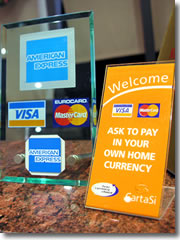- Places
- Plans
- Itineraries
- Experiences

Money makes the world go round—and will make your trip to Italy go smoothly, no matter in what form you carry it (starting with the cheapest and easiest):
As much as this site is devoted to ways to travel to Italy on the cheap, you gotta spend money at some point (though there is quite a lot of sightseeing you can do for free).
Here's how to get money during your travels, strategies for getting the best deals on exchange rates, how to avoid scams and rip-offs, how to wire money, and ways to save money every step of the way on your vacation—as well as some of the worst money-saving tips you should not follow.
This section will also cross over with the shopping section by giving you the skinny on getting VAT taxes refunded and dealing with U.S. Customs regulations.
What kind of money do they use in Italy? Italy uses euros. This is the same currency now used by most of Western Europe (except Switzerland, the U.K., and parts of Scandinavia). These days, a euro—the currency symbol looks like this: €—is worth a bit more than a U.S. dollar (currently fluctuating between about $1.40 to $1.50 to €1). This is called the exchange rate, and the lower this number, the better off you are, since it will cost you less to buy each euro. Euros come in coins colored copper (€0.01, €0.02, €0.05), gold (€0.10, €0.20, €0.50), and two-tone (€1, €2), and in bills of €5, €10, €20, €50, €100, €200, and €500. » more
| English (Inglese) | Italian (Italiano) |
| Where is? | Dov'é (doh-VAY) |
| ...an ATM | un bancomat (oon BAHN-ko-maht) |
| ...a bank | una banca (OO-nah BAHN-kah) |
| ...an exchange booth | un cambio (oon CAHM-bee-yo) |
| How much is it? | Quanto costa? (KWAN-toh COST-ah) |
| That's too much | É troppo (ay TROH-po) |
| if I pay cash? | se pago con contanti (say PAH-go cohn cone-TAHN-tee) |
| credit card | carta di credito (CAR-tah dee CRAY-dee-toe) |
| discount | sconto (SKOHN-toe) |
| sale | saldi (SAHL-dee) |
| thank you | grazie (GRAT-tzee-yay) |
| please | per favore (pair fa-VOHR-ray) |
| yes | si (see) |
| no | no |
| Do you speak English? | Parla Inglese? (PAR-la een-GLAY-zay) |
| I don't understand | Non capisco (non ka-PEESK-koh) |
| I'm sorry | Mi dispiace (mee dees-pee-YAT-chay) |
Share this page
Search ReidsItaly.com